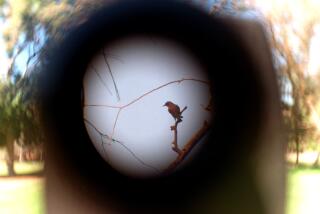Look! Up in the Sky! It’s a Bird! It’s a Plane! It’s Envious Man!
“Flying creatures will support man with their feathers,” Leonardo da Vinci wrote in his notebook. He tried to prove his prophecy true by designing, and possibly constructing, an ornithopter capable of carrying a human being into the skies. Five centuries later, on June 22, 1979, Paul MacCready performed an engineering feat of similar kind when his Gossamer Albatross flew across the English Channel using only the pilot’s two legs as motor power. Last month MacCready, swollen with the hubris belonging to dreams of flight, watched another of his ambitious inventions, a radio-controlled plastic replica of a pterosaur, nose-dive into a crash-landing shortly after takeoff. By inevitably summoning memories of other recent aerial disasters, especially that of the space shuttle Challenger, MacCready’s Icarian project offers us another opportunity to raise the question: Why fly?
Leonardo had a ready answer: We fly because we envy birds their power to escape danger and death. In one of his fables he imagines an ogre of satanic visage advancing on mankind. “In truth the human species in such a plight has need to envy every other race of creatures,” he wrote, and lamented that “for us wretched mortals there avails not any flight, since this monster when advancing slowly far exceeds the speed of the swiftest courser.” Though Sigmund Freud did not comment on this fable in his book about Leonardo, it does not take a genius of Freud’s magnitude to identify the monster as the death that advances remorselessly on each human person, rousing in him or her fantasies of escape from the cycle of generation and decay that characterizes earthbound life. Leonardo’s fable of aggression has a political aspect as well, to which I shall return.
In the history of the human imagination the bird has served as a symbol of magical ascent above and beyond the human condition. “Thou wast not born for death, immortal Bird!” declaimed John Keats in his envious ode to the nightingale. John Burroughs noted plaintively, “There is something almost pathetic in the fact that the bird remains forever the same. You grow old, your friends die or move to distant lands . . . . Yet there in your garden or orchard are the birds of your boyhood, the same notes, the same calls, and, to all intents and purposes, the identical birds endowed with perennial youth.” For those same intents and purposes human beings compelled themselves by imitative magic to make bird-machines in order to ward off the evil destiny carried in their genes. Aviation, as Freud concluded, is an expression of the infantile wish to achieve absolute and unlimited power in the world of time and space.
Envy, then, is the mainspring of our desire to become birdmen, as the earliest pilots were called. Envy, as Harry Stack Sullivan wrote, is simply “an active realization that one is not good enough.” Not good enough to survive, unless some miracle intervenes. The bird-machine is that miracle, and when it fails us we are plunged into the kind of profound mourning that oppressed the nation after the Challenger catastrophe.
Something more needs to be said about our cultural obsession with flight. Leonardo’s threatening monster clearly derived in part from the milieu of warfare between city-states in his time. Air power promised him and his patron princes protection from invasion by rival armies. In our time it hardly needs demonstrating that governments have endowed aerial technology with magical significance. Nuclear missiles and SDI-type projects alike are charged with the mission of safeguarding our living societies in perpetuity. And, if weapons fail, we are making plans for flying machines to bring us to the refuge of space stations and space colonies. The high frontier beckons everyone haunted by credible scenarios of nuclear extinction.
As a nation we adopted the eagle, the Roman bird of empire, as our totem. In the Apollo moon landings it brought us joy and hope. Even technophobe Norman Mailer changed his opinion of flying machines when gazing at the Saturn-Apollo rocket. Writing of himself in the third person, he tells us in “Of a Fire on the Moon”: “It was simple masculine envy. He too wanted to go up in the bird.” We all want to go up in the bird, to be good enough to transcend what we cannot defeat. In this hard year NASA has wounded our pride and renewed our primal anxieties. We feel immensely vulnerable to ogres again. What meaning, then, should we attach to the failure of Paul MacCready’s pterosaur, that unwieldy likeness of a race of flying lizards put to death by evolution?
First, we should applaud MacCready’s fantastical sense of play in devising such a thing. In true modernist spirit his antediluvian figure is more a parody of the gigantism in aeronautical design than anything else. One is glad to see the Smithsonian’s Air and Space Museum backing such a project. The antidote to a pathology of envy is just such a relaxed support for whatever artifacts ingenious craftsmen like MacCready bring into the world.
Also, this self-destructed replica could purge our imaginations of shame for the fate of Challenger. Karl Marx thought that events happen twice in history--first as tragedy, then as farce. If this is true, surely the farcical ought to refresh our sense of the tragical, and by doing so allow us to unclench our psyches from the almost vindictive rage that we have felt toward the mysterious forces that killed our astronauts. The Challenger disaster caused a disillusionment with NASA enterprises that militarists were quick to exploit. The martyred heroes were to be avenged by putting more potent and invulnerable craft into space, we were told. Russia would learn that Americans are good enough. To make sport of flight in the midst of so much gravity and so much sorrow, as MacCready did by sending up his blithe spirit, reminds us that we are free to imagine and build anything that flies, be it ultralight or interplanetary, free to choose among a variety of designs according to our earthbound desires, free as a bird.
More to Read
Sign up for our Book Club newsletter
Get the latest news, events and more from the Los Angeles Times Book Club, and help us get L.A. reading and talking.
You may occasionally receive promotional content from the Los Angeles Times.






